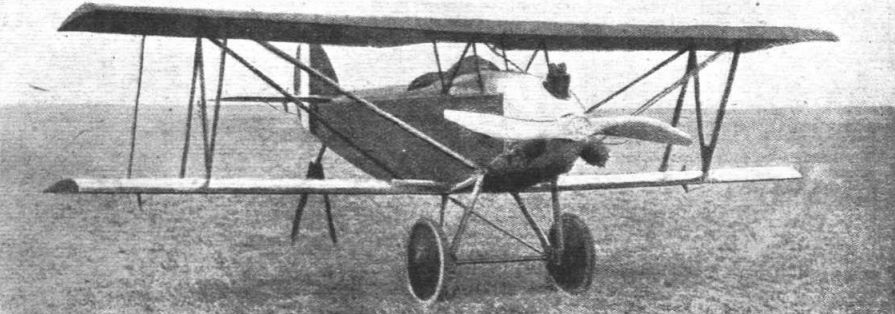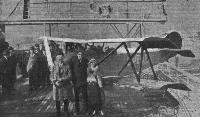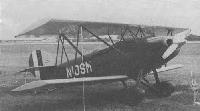Sperry/Engineering Division Messenger
В 1921 году инженерно-техническим подразделением Авиационной службы Армии США был спроектирован одноместный биплан Messenger, который предназначался для использования в качестве самолета связи между командирами армейских полевых частей и штабами. Самолет имел традиционную конфигурацию биплана с размахом крыльев 6,10 м и оснащался звездообразным двигателем Lawrance L-4 мощностью 60 л. с., позволявшим машине развивать максимальную скорость 156 км/ч. Самолет строился компанией "Sperry Aircraft Company", основанной Лоуренсом Сперри в Фармингдейле, штат Нью-Йорк. Всего собрали 42 экземпляра, включая опытные. Самолеты Messenger использовались и для экспериментальных целей: восемь из первых 12-ти были собраны как радиоуправляемые "воздушные торпеды" (фактически - прообраз современных крылатых ракет), а другие использовались в испытаниях по взаимодействию с дирижаблями (самолет получал специальное оборудование, позволявшее ему "производить стыковку" с дирижаблями). В 1924 году самолетам присвоили новые обозначения: 18 из первых 26 самолетов стали M-1, восемь радиоуправляемых самолетов - MAT (Messenger Aerial Torpedo), а последние 16 машин, имевшие увеличенный запас топлива, - M-1A. Один гражданский самолет, пилотируемый Лоуренсом Сперри, во время перелета в Великобританию совершил вынужденную посадку в проливе Ла-Манш. Сперри погиб, и вскоре его компания прекратила свое существование.
Показать полностьюShow all
Flight, February 1921
THE SPERRY "MESSENGER" BIPLANE
ONE of the uses - and quite an important one, we think - to which the aeroplane can be put on the military side, is that of dispatch carrying, work usually done by motorcycles. The advantages of the former over the latter are obvious, not only in the matter of speed, but on account of the aeroplane being independent of roads. If the machine is designed so that it is small, easily dismantled and assembled, and has a low landing speed without sacrificing performance, then one can also be more or less independent of aerodromes. The Engineering Division of the U.S. Air Service designed such a machine as outlined above, specially for dispatch carrying, the following brief particulars of which are given in our American contemporary, Aviation.
This machine, which was built by the Lawrence Sperry Aircraft Co., Inc., of Long Is., N.Y., is a single-seater rigid truss tractor biplane of pleasing appearance. Incidentally, it possesses all the characteristics that make for a successful "Sportplane," and is not, therefore, a machine for military work only. The Lawrence 60 h.p. three-cylinder air-cooled engine, with which it is fitted, neatly blends into the nicely streamlined fuselage of plywood, leaving only the cylinders exposed to the air, while the streamline tubular truss bracing and struts all offer the minimum of head resistance.
The wings, ailerons and tail surfaces are easily detachable, and many of the parts are interchangeable, as, for instance, such parts as the upper and lower wings, and the ailerons. Structurally the machine differs slightly from standard practice, which difference is principally in the rigid type of wing trussing, made of round steel tubing streamlined with balsa wood. The upper wings are attached to a small centre section panel, the width of the fuselage, mounted above the latter on a pair of N-struts. The lower wings are attached direct to the bottom longerons of the fuselage. One pair of N-form interplane struts on each side connect upper and lower wings, both of which are set at a dihedral angle of about 1 1/2 degs. The wings are of good design and construction, special care having been taken to produce wings which were strong and simple in construction, as well as being capable of quick assembly on the field. There is but one lift wire - from the front lower wing-spar root to the top of the rear interplane strut member - the rest of the flying and landing loads being taken up by the steel struts. After the machine has once been assembled and the proper length found for the struts, it can be reassembled in a few minutes without repeated adjustments.
The main spars are of channelled spruce, and the ribs are built up of mahogany webs, with spruce cap strips. The wings were sand tested at McCook Field, standing a factor of safety of seven without failing. They were also tested for inverted flight to an F.S. of four without failure.
The fuselage is of usual longeron and diagonal strut type, covered with three-ply mahogany. The pilot's cockpit is roomy and neatly upholstered. A large instrument board with a complete set of instruments, including two tachometers, altimeter, compass, oil gauge, clock, and engine switch, is mounted conveniently in the cockpit. The deck fairing and wind-shield in front of the pilot are so arranged that, while giving a good view, it deflects the air from the pilot's face, making it unnecessary to wear goggles. The controls are of the standard stick and rudder bar type.
The 60 h.p. Lawrence air-cooled engine fitted to this machine has given wonderful results on several tests carried out by the Government. It ran through the standard 50-hr, test without the slightest indication of trouble or wear. The engine is supported by two steel plates on either side, which are bolted to the fuselage nose veneer panel, giving a strong and flexible mounting. The petrol tank is built in two compartments, the lower or main tank containing 6.7 gals., and the upper or auxiliary tank containing 3.3 gals., a total capacity sufficient for 2 hrs.
The Sperry "Messenger" has been through a number of wind-tunnel tests, and the best stabiliser setting was determined, with the result that very satisfactory longitudinal stability was obtained. The stability of the machine is reported to be good under both high and low speeds, and the difference can hardly be felt on the control stick under these two conditions. It is said that the controllability is remarkable on all three controls, and without the tendency to act too quickly. In this respect it is comparable to the S.E.-5, while the manoeuvrability is likened to that of the Nieuport (French). It is interesting to note that the performance of this machine, with only 60 h.p. and a wing curve - U.S.A.15 - which was designed for high lift while sacrificing added resistance at high speed has as good, if not better, a performance than most machines having the same loading/sq. ft. and /h.p.
The principal characteristics of the Sperry "Messenger" are :-
Span 20 ft. 0 ins.
Chord 4 ft. 0 ins.
Over-all length 18 ft. 0 ins.
Height 7 ft. 0 ins.
Gap 3 ft. 9 ins.
Stagger 1 ft. 6 ins.
Area of main planes 152 sq. ft.
Area of ailerons (4) 19 sq. ft.
Area of tail plane 12.3 sq.ft.
Area of elevators 9 sq. ft.
Area of fin 25 sq.ft.
Area of rudder 5.3 sq. ft.
Weight, empty 581 lbs.
Weight, loaded 820 lbs.
Loading/sq. ft. 5.4 lbs.
Loading/h.p. 13.5 lbs.
Speed range 35-95 m.p.h.
Climb in 10 mins. 10,000 ft.
Показать полностьюShow all








